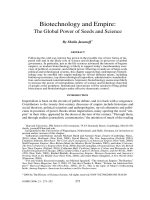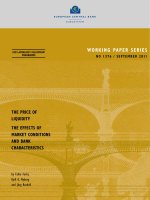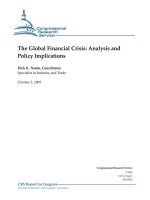Chapter 21 The Global Capital Market: Performance and Policy Problems
Bạn đang xem bản rút gọn của tài liệu. Xem và tải ngay bản đầy đủ của tài liệu tại đây (527.31 KB, 48 trang )
Chapter 21
The Global
Capital Market:
Performance and
Policy Problems
Slides prepared by Thomas Bishop
Preview
• Gains from trade
• Portfolio diversification
• Players in the international capital markets
• Attainable policies with international capital markets
• Offshore banking and offshore currency trading
• Regulation of international banking
• Tests of how well international capital markets allow
portfolio diversification, allow intertemporal trade and
transmit information
Copyright © 2006 Pearson Addison-Wesley. All rights reserved.
21-2
International Capital Markets
• International capital markets are a group of markets
(in London, Tokyo, New York, Singapore, and other
financial cities) that trade different types of financial
and physical capital (assets), including
stocks
bonds (government and corporate)
bank deposits denominated in different currencies
commodities (like petroleum, wheat, bauxite, gold)
forward contracts, futures contracts, swaps, options contracts
real estate and land
factories and equipment
Copyright © 2006 Pearson Addison-Wesley. All rights reserved.
21-3
Gains from Trade
• How have international capital markets increased the
gains from trade?
• When a buyer and a seller engage in a voluntary
transaction, both receive something that they want
and both can be made better off.
• A buyer and seller can trade
goods or services for other goods or services
goods or services for assets
assets for assets
Copyright © 2006 Pearson Addison-Wesley. All rights reserved.
21-4
Gains from Trade (cont.)
Copyright © 2006 Pearson Addison-Wesley. All rights reserved.
21-5
Gains from Trade (cont.)
• The theory of comparative advantage
describes the gains from trade of goods and
services for other goods and services:
with a finite amount of resources and time, use
those resources and time to produce what you are
most productive at (compared to alternatives), then
trade those products for goods and services that
you want.
be a specialist in production, while enjoying many
goods and services as a consumer through trade.
Copyright © 2006 Pearson Addison-Wesley. All rights reserved.
21-6
Gains from Trade (cont.)
• The theory of intertemporal trade describes the
gains from trade of goods and services for assets, of
goods and services today for claims to goods and
services in the future (today’s assets).
Savers want to buy assets (future goods and services)
and borrowers want to use assets (wealth) to consume or
invest in more goods and services than they can buy with
current income.
Savers earn a rate of return on their assets, while borrowers
are able to use goods and services when they want to use
them: they both can be made better off.
Copyright © 2006 Pearson Addison-Wesley. All rights reserved.
21-7
Gains from Trade (cont.)
• The theory of portfolio diversification
describes the gains from trade of assets for
assets, of assets with one type of risk with
assets of another type of risk.
Many times in economics (though not in Las
Vegas) people want to avoid risk: they would
rather have a sure gain of wealth than invest in
risky assets.
Economists say that investors often display risk
aversion: they are averse to risk.
Diversifying or “mixing up” a portfolio of assets is a
way for investors to avoid or reduce risk.
Copyright © 2006 Pearson Addison-Wesley. All rights reserved.
21-8
Portfolio Diversification
• Suppose that 2 countries have an asset of farmland
that yields a crop, depending on the weather.
• The yield (return) of the asset is uncertain, but with
bad weather the land can produce 20 tonnes of
potatoes, while with good weather the land can
produce 100 tonnes of potatoes.
• On average, the land will produce 1/2 * 20 + 1/2 * 100
= 60 tonnes if bad weather and good weather are
equally likely (both with a probability of 1/2).
The expected value of the yield is 60 tonnes.
Copyright © 2006 Pearson Addison-Wesley. All rights reserved.
21-9
Portfolio Diversification (cont.)
• Suppose that historical records show that when the
domestic country has good weather (high yields), the
foreign country has bad weather (low yields).
• What could the two countries do to make sure they do
not have to suffer from a bad potato crop?
• Sell 50% of one’s assets to the other party and buy
50% of the other party’s assets:
diversify the portfolios of assets so that both countries always
achieve the portfolios’ expected (average) values.
Copyright © 2006 Pearson Addison-Wesley. All rights reserved.
21-10
Portfolio Diversification (cont.)
• With portfolio diversification, both countries could
always enjoy a moderate potato yield and not
experience the vicissitudes of feast and famine.
If the domestic country’s yield is 20 and the foreign country’s
yield is 100 then both countries receive:
50%*20 + 50%*100 = 60.
If the domestic country’s yield is 100 and the foreign
country’s yield is 20 then both countries receive:
50%*100 + 50%*20 = 60.
If both countries are risk averse, then both countries could be
made better off through portfolio diversification.
Copyright © 2006 Pearson Addison-Wesley. All rights reserved.
21-11
Classification of Assets
Claims on assets (“instruments”) are classified as either
1. Debt instruments
Examples include bonds and bank deposits
They specify that the issuer of the instrument must repay
a fixed value regardless of economic circumstances.
2. Equity instruments
Examples include stocks or a title to real estate
They specify ownership (equity = ownership) of variable
profits or returns, which vary according to economic
conditions.
Copyright © 2006 Pearson Addison-Wesley. All rights reserved.
21-12
International Capital Markets
The participants:
1. Commercial banks and other depository
institutions:
accept deposits
lend to governments, corporations, other banks,
and/or individuals
buy and sell bonds and other assets
Some commercial banks underwrite stocks and
bonds by agreeing to find buyers for those assets
at a specified price.
Copyright © 2006 Pearson Addison-Wesley. All rights reserved.
21-13
International Capital Markets (cont.)
2. Non bank financial institutions: pension funds,
insurance companies, mutual funds, investment
banks
Pension funds accept funds from workers and invest them
until the workers retire.
Insurance companies accept premiums from policy holders
and invest them until an accident or another unexpected
event occurs.
Mutual funds accept funds from investors and invest them
in a diversified portfolio of stocks.
Investment banks specialize in underwriting stocks and
bonds and perform various types of investments.
Copyright © 2006 Pearson Addison-Wesley. All rights reserved.
21-14
International Capital Markets (cont.)
3. Private firms:
Corporations may issue stock, may issue bonds or may
borrow from commercial banks or other lenders to acquire
funds for investment purposes.
Other private firms may issue bonds or borrow from
commercial banks.
4. Central banks and government agencies:
Central banks sometimes intervene in foreign exchange
markets.
Government agencies issue bonds to acquire funds, and
may borrow from commercial or investment banks.
Copyright © 2006 Pearson Addison-Wesley. All rights reserved.
21-15
International Capital Markets (cont.)
•
Because of international capital markets,
policy makers generally have a choice of 2
of the following 3 policies:
1. A fixed exchange rate
2. Monetary policy aimed at achieving domestic
economic goals
3. Free international flows of financial capital
Copyright © 2006 Pearson Addison-Wesley. All rights reserved.
21-16
International Capital Markets (cont.)
• A fixed exchange rate and an independent monetary
policy can exist if restrictions on flows of financial
capital prevent speculation and capital flight.
• Independent monetary policy and free flows of
financial capital can exist when the exchange rate
fluctuates.
• A fixed exchange rate and free flows of financial
capital can exist if the central bank gives up its
domestic goals and maintains the fixed exchange
rate.
Copyright © 2006 Pearson Addison-Wesley. All rights reserved.
21-17
Offshore Banking
•
Offshore banking refers to banking outside
of the boundaries of a country.
•
There are at least 4 types of offshore
banking institutions, which are regulated
differently:
1.
An agency office in a foreign country makes
loans and transfers, but does not accept
deposits, and is therefore not subject to
depository regulations in either the domestic or
foreign country.
Copyright © 2006 Pearson Addison-Wesley. All rights reserved.
21-18
Offshore Banking (cont.)
2. A subsidiary bank in a foreign country
follows the regulations of the foreign
country, not the domestic regulations of the
domestic parent.
3. A foreign branch of a domestic bank is
often subject to both domestic and foreign
regulations, but sometimes may choose the
more lenient regulations of the two.
Copyright © 2006 Pearson Addison-Wesley. All rights reserved.
21-19
Offshore Banking (cont.)
4. International banking facilities are foreign
banks in the US that are allowed to accept
deposits from and make loans to foreign
customers only. They are not subject to
reserve requirement regulations, interest
rate ceilings and state and local taxes.
Bahrain, Singapore and Japan have similar
regulations for offshore banks.
Copyright © 2006 Pearson Addison-Wesley. All rights reserved.
21-20
Offshore Currency Trading
• An offshore currency deposit is a bank deposit
denominated in a currency other than the
currency that circulates where the bank
resides.
An offshore currency deposit may be deposited in a
subsidiary bank, a foreign branch, a foreign bank or
another depository institution located in a foreign
country.
Offshore currency deposits are sometimes
(unfortunately) referred to as eurocurrencies,
because these deposits were historically made in
European banks.
Copyright © 2006 Pearson Addison-Wesley. All rights reserved.
21-21
Offshore Currency Trading (cont.)
Offshore currency trading has grown for three
reasons:
1.
growth in international trade and international
business
2.
avoidance of domestic regulations and taxes
3.
political factors (e.g., to avoid confiscation by a
government because of political events)
Copyright © 2006 Pearson Addison-Wesley. All rights reserved.
21-22
Offshore Currency Trading (cont.)
• Reserve requirements are the primary example of a
domestic regulation that banks have tried to avoid
through offshore currency trading.
Depository institutions in the US and other countries are
required to hold a fraction of domestic currency deposits on
reserve at the central bank.
These reserves can not be lent to customers and do not
interest in many countries, therefore the reserve requirement
acts a tax for banks.
Offshore currencies in many countries are not subject to this
requirement, and thus the total amount of deposits can earn
interest if they become offshore currencies.
Copyright © 2006 Pearson Addison-Wesley. All rights reserved.
21-23
Balance Sheet for Bank
Assets
Liabilities + Net worth
Reserves at central bank
Deposits
Loans
-business
-home
-car
-real estate
Borrowed funds
Government and
corporate bonds
Copyright © 2006 Pearson Addison-Wesley. All rights reserved.
Net worth = bank capital
21-24
Regulation of International Banking
• Banks fail because they do not have enough or the
right kind of assets to pay for their liabilities.
The principal liability for commercial banks and other
depository institutions is the value of deposits, and banks fail
when they can not pay their depositors
If many loans (a type of asset) fail or if the value of assets
decline in another manner, then liabilities could become
greater than the value of assets and bankruptcy could result.
• In many countries there are several types of
regulations to avoid bank failure.
Copyright © 2006 Pearson Addison-Wesley. All rights reserved.
21-25









